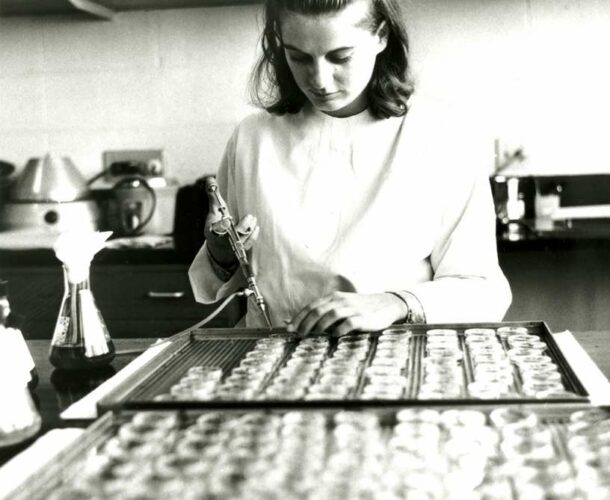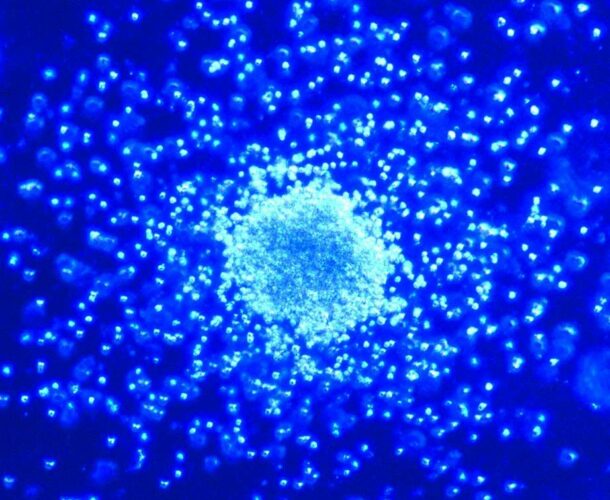The history of the discovery of CSFs can be traced back to an accidental discovery.
Until 1966, Professor Don Metcalf had spent a substantial period of his time at the institute working in immunology, however his real passion was cancer research, particularly leukaemia.
Beginning with leukaemia and bone marrow
Leukaemia is a cancer of blood cells which begins in the bone marrow, and Metcalf had begun a collaboration with Ray Bradley across the road at The University of Melbourne, who was also interested in leukaemia and bone marrow cells.
Bradley and Metcalf set about trying to grow leukaemia cells from mice using an exciting new technique that Bradley had learned in Denver, US, from one of the pioneers of tissue culture, Theodore Puck.
The researchers intended to use bone marrow cells to ‘feed’ the leukaemia cells and stimulate them to grow and multiply. However the leukaemia cells would not grow.
A remarkable discovery
But something remarkable was happening in those petri dishes. Metcalf remembers the day that Bradley brought the cell dishes to the institute in 1965. Bradley and Metcalf had inadvertently discovered a way to grow bone marrow cells.
“He brought the cultures over to us in the animal house. And it was raining as I remember, him carrying them in, out of the rain. Look at these,” Metcalf later recalled.
“Nobody in the world had ever been able to grow bone marrow before, ever. There were books written saying it couldn’t be done. And so what had happened was that the leukemic cells were making something that was making the bone marrow cells make colonies.”1
In Metcalf’s reminiscence of the 35-year saga of CSFs Summon up the Blood, Metcalf wrote:
“I challenge anyone on first seeing such colonies not to be astonished and intrigued. These colonies are three-dimensional populations of cells of wonderfully variable shapes and sizes, and look like galaxies as approached by a fast-moving spaceship. Their beauty continues to fascinate me, even after 35 years.”2
The beginning of the CSFs journey
Metcalf had seen the significance of their discovery immediately.
“Two things became pretty obvious. For the first time in history, people could grow blood-forming cells as colonies. It turned out that (as had seemed likely) they were clones, each one coming from a single cell – and they made a colony of daughter cells during a week of incubation. But unless you added something to the medium in the culture, colonies would not grow. That something we called colony stimulating factor, CSF.”3
This instrumental discovery was the beginning of CSFs journey; a Herculean 35-year journey that has, to date, improved or saved the lives of more than 20 million people worldwide.
A leap of faith
Metcalf and his colleagues took a leap of faith, the “optimistic view that the colony-stimulating activity being supplied to the cultures by added cells or conditioned media was in fact a mandatory … regulator of granulocytes and macrophages.
“This was to remain a hopeful but unverifiable premise throughout almost 20 years of subsequent work”4, until the isolation of the first CSFs – GM-CSF led by Professor Tony Burgess and G-CSF led by Professor Nick Nicola.
“Every so often there is an accidental occurrence like that, when you would have to be blind not to realise that here is something astonishing that warranted a few decades’ work – and so it proved.”5
Metcalf realised immediately that this technique would “allow him to define the hormones that regulated the process [of blood cell growth]. Don worked on nothing else for the next 50 years.”
1. http://www.australianbiography.gov.au/subjects/metcalf/intertext3.html. Accessed 27 June 2015.
2. Donald Metcalf, Summon up the Blood: in dogged pursuit of the blood cell regulators, p7
3. https://www.science.org.au/teachers-notes-professor-donald-metcalf. Accessed 27 June 2015
4. Metcalf, p19
5. https://www.science.org.au/teachers-notes-professor-donald-metcalf. Accessed 27 June 2015
6. Hilton DJ, Nicola NA, Alexander WS, Roberts AW, Dunn AR. Obituary: Donald Metcalf (1929-2014). 2014. 160(3):361–362.











